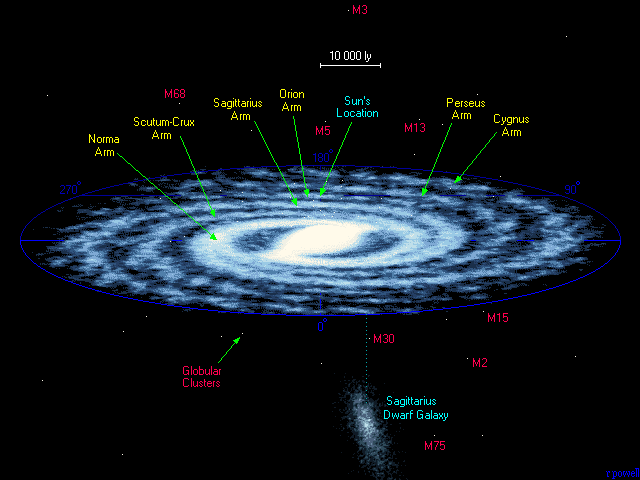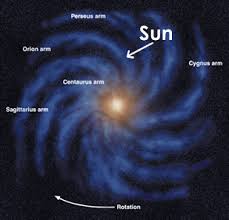Milky Way galaxy may have formed inside-out
Our milky way galaxy may have formed from the inside-out, according to a ground-breaking study which provides new insight into galactic evolution.
Data from the Gaia-ESO project has provided evidence backing theoretically predicted divisions in the chemical composition of the stars that make up the Milky Way's disc - vast collection of giant gas clouds and billions of stars that give our galaxy its 'flying saucer' shape.

The research suggests that stars in the inner regions of the galactic disc were the first to form, supporting ideas that our galaxy grew from the inside-out.
An international team of astronomers took detailed observations of stars with a wide range of ages and locations in the galactic disc to accurately determine their 'metallicity': the amount of chemical elements in a star other than hydrogen and helium, the two elements most stars are made from.
Immediately after the Big Bang, the universe consisted almost entirely of hydrogen and helium, with levels of "contaminant metals" growing over time.
Consequently, older stars have fewer elements in their make-up - so have lower metallicity, researchers said.
The team have shown that older, 'metal-poor' stars inside the Solar Circle - the orbit of our Sun around the centre of the Milky Way - are far more likely to have high levels of magnesium.
The higher level of the element inside the Solar Circle suggests this area contained more stars that "lived fast and die young" in the past, researchers said.

The stars that lie in the outer regions of the galactic disc are predominantly younger, both 'metal-rich' and 'metal-poor', and have surprisingly low magnesium levels compared to their metallicity.
This discovery signifies important differences in stellar evolution across the Milky Way disc, with very efficient and short star formation timescales occurring inside the Solar Circle; whereas, outside the Sun's orbit, star formation took much longer.
"We have been able to shed new light on the timescale of chemical enrichment across the Milky Way disc, showing that outer regions of the disc take a much longer time to form," said Maria Bergemann from Cambridge University's Institute of Astronomy, who led the study.
The study appears in the journal Astronomy and Astrophysics.
Shailesh shukla
directoratace@gmail.com
Our milky way galaxy may have formed from the inside-out, according to a ground-breaking study which provides new insight into galactic evolution.
Data from the Gaia-ESO project has provided evidence backing theoretically predicted divisions in the chemical composition of the stars that make up the Milky Way's disc - vast collection of giant gas clouds and billions of stars that give our galaxy its 'flying saucer' shape.
Data from the Gaia-ESO project has provided evidence backing theoretically predicted divisions in the chemical composition of the stars that make up the Milky Way's disc - vast collection of giant gas clouds and billions of stars that give our galaxy its 'flying saucer' shape.

The research suggests that stars in the inner regions of the galactic disc were the first to form, supporting ideas that our galaxy grew from the inside-out.
An international team of astronomers took detailed observations of stars with a wide range of ages and locations in the galactic disc to accurately determine their 'metallicity': the amount of chemical elements in a star other than hydrogen and helium, the two elements most stars are made from.
Immediately after the Big Bang, the universe consisted almost entirely of hydrogen and helium, with levels of "contaminant metals" growing over time.
Consequently, older stars have fewer elements in their make-up - so have lower metallicity, researchers said.
The team have shown that older, 'metal-poor' stars inside the Solar Circle - the orbit of our Sun around the centre of the Milky Way - are far more likely to have high levels of magnesium.
The higher level of the element inside the Solar Circle suggests this area contained more stars that "lived fast and die young" in the past, researchers said.
The stars that lie in the outer regions of the galactic disc are predominantly younger, both 'metal-rich' and 'metal-poor', and have surprisingly low magnesium levels compared to their metallicity.
This discovery signifies important differences in stellar evolution across the Milky Way disc, with very efficient and short star formation timescales occurring inside the Solar Circle; whereas, outside the Sun's orbit, star formation took much longer.
"We have been able to shed new light on the timescale of chemical enrichment across the Milky Way disc, showing that outer regions of the disc take a much longer time to form," said Maria Bergemann from Cambridge University's Institute of Astronomy, who led the study.
The study appears in the journal Astronomy and Astrophysics.
Shailesh shukla
directoratace@gmail.com
No comments:
Post a Comment